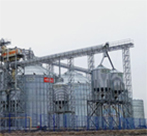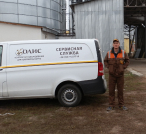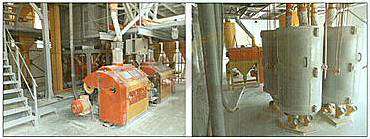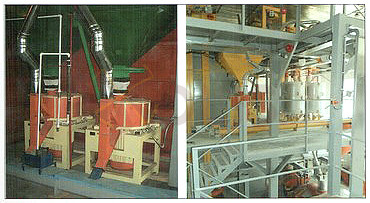E. Dmitruk, Doctor of Technical Sciences
Professor T. MISTULOV, candidate of pedagogical sciences, senior researcher at the National University of Food Technologies (Kiev)
A. Vereshchinsky, Candidate of Technical Sciences, General Director of LLC “OLIS” (Odessa)
One of the main regulatory documents regulating the efficiency of the flour milling industry is the existing “Rules for organizing and maintaining the technological process at flour mills” [1]. Its creation is based on many years of scientific substantiation and practical experience in the development of grain grinding technologies. However, the mill industry, which Ukraine inherited from the Soviet Union, was formed and developed for a long time in difficult political and economic conditions, too different from the conditions of today. Thus, “Rules…”, edition 1998, to a large extent also inherited the approaches of economic conditions that do not currently exist and do not provide for the development of technologies and equipment for 15 or more years in the future.
Analysis of the latest flour-grinding technologies and the practice of their effective use shows a number of contradictions with the current regulatory framework, which needs improvement, and sometimes even revision. According to the current “Rules…” existing grain grindings are classified according to the level of development of their structures into types, specified by standard technological solutions and corresponding recommended processing modes.Each of the provided types of grinding is associated with calculated product yield standards (basic yield), which must be ensured when processing grain with certain quality indicators. If the actual data of processed grain deviates from the calculated data, there are corresponding allowances and discounts.
However, this classification does not provide for grinding with short structures at all, that is, without enrichment (photo 1), which is now widely used to produce high-quality wheat baking flour, including premium grade, in low-power mills (up to 50-60 tons/day).
Photo.1. Flour mill with a capacity of 30 t/day with a reduced structure
| Flour type | Single-grade grinding | Double grinding | Three-grade grinding |
| Highest, % | 68 -70 | 50 – 55 | 50 – 55 |
| First, % | 15 – 20 | 15 – 20 | |
| Second, % | 1 – 2 | ||
| Total, % | 68 – 70 | 71 – 73 | 72 – 74 |
The variety of flour mills that implement grinding according to reduced schemes, that is, with less enrichment (photo 2), has long gone beyond the structures, regimes and practical solutions provided for by the “Rules…”. At such enterprises, multi- and single-grade grinding was carried out with the yield of the highest grade, which is also not provided for by the current “Rules…” But carrying out double-grade grinding with the yield of first-grade flour and a significant yield of the second (up to 38%), as stated in the “Rules…”, it is devoid of economic feasibility and has not been used in practice for a long time.
Photo.2. Flour mill with a capacity of 60 t/day with a reduced structure
| Flour type | Single-grade grinding | Double grinding | Three-grade grinding |
| Highest, % | 70 – 72 | 60 – 65 | 60 – 65 |
| First, % | 10 – 15 | 10 – 15 | |
| Second, % | 1 – 2 | ||
| Total, % | 70 – 72 | 73 – 74 | 74 – 75 |
The only standard scheme that has remained virtually unchanged and has been in operation for three decades is the one that implements grain grinding with advanced enrichment. In production, it was introduced using complete equipment from the Büller company at flour mills with a capacity of 250 and 500 tons/day. But these enterprises, focused on the maximum use of grinding grain into flour, remain quite energy-intensive and require changes in energy saving and rational use of resources.
It has been established that for the majority of grinding batches of domestic wheat, the economically feasible flour yield is in the range of 70-72% [2, 3], not exceeding 73-74%. Deterioration in the quality of grinding due to the inclusion of flour in its composition leads to a loss of income rather than to its increase due to an increase in the amount of flour. Improving such productions necessarily requires changing their structure and processing modes, as well as reorienting the assortment towards lowering the overall yielddue to second-grade milling and increasing the yield of premium flour, which is a significant difference from the norms established by the “Rules…”< /strong>
In our opinion, in order to bring the regulatory framework into line with today’s requirements, it is necessary to detail and expand the classification of existing grinding structures according to the main characteristic features, which generally reflect the technical level and technological capabilities of production. Their standard performance indicators can be expressed, for example, by the value of the product of the total flour yield and its weighted average whiteness without standardizing the total yield and flour yield by grade.
The formation of grinding varieties and ensuring certain indicators of its whiteness within the values standardized by flour standards should be the subject of a mutual agreement between the manufacturer and the consumer.Practical implementation of each of these structures in the form of a technological scheme, establishment of grain processing modes, as well as quantitative and qualitative indicators of grinding balances must be the responsibility of the technology developer and must be provided by him.
The existing requirements for grain quality and the efficiency of technological operations, the system of discounts and surcharges on the output of processed products when the actual indicators of processed grain deviate from the calculated ones provided for by the “Rules…” also require improvement.
Thus, the results of the work of mills over several years have shown [4] that with an increase in the content of impurities by 0.1% in the grain before the I torn system, the total flour yield decreases by approximately by 1.4%.An increase in the presence of grain impurities in purified grain by 1.0% leads to a deterioration in the overall flour yield by approximately 0.8%. The practice of grinding shows that when increasing the quality indicators and yield of flour, especially high grades, careful removal of impurities is necessary. This should be reflected accordingly in the regulatory framework. Moreover, the latest means of increasing cleaning efficiency exist and are widely used.
The difference in the glassiness of the grain affects the results of grinding in different structures to a different extent. Of course, a decrease in the amount of large intermediate products and an increase in small ones due to a decrease in glassiness leads to significant difficulties in the operation of flour mills with developed structures. However, this factor has a much smaller effect on the results of grinding with reduced and short structures.At the same time, processing grain with high glassiness often creates difficulties in the operation of mills with a short structure due to the insufficient equipment of the grinding process with grinding equipment.
The advantages of assessing flour quality based on whiteness indicators have been proven by a number of studies [5], and are also recognized by producers and consumers of this product. In this case, the ash content of the grain, which is largely determined by the ash content of the endosperm, cannot serve as a basis for calculating the grinding results. The nature of the grain in a certain way reflects a complex of various flour-grinding properties of the grain, but depends on many factors that do not have a correlation with the results of grinding, for example, humidity or surface condition.Obviously, indicators are more suitable for adjusting the calculated values of flour yield, which can more accurately characterize the specific content of endosperm in the grain. For example, the total amount of gluten and starch [6].
Undoubtedly, the above analysis is sufficient to confirm the fact that flour production technologies are a dynamic system that is constantly changing in accordance with economic conditions, the latest grain processing methods, product quality control and use progressive equipment. The current state of the flour milling industry requires reforming its regulatory framework. For example, the reissue of the “Rules…”, which will be the key to increasing the efficiency of flour production in Ukraine.
- Kroshko G.D. Rules for organizing and conducting the technological process at boron mills [Text] / G.D. Kroshko (that in.). – K.: Vipol. 1998. – 145 p.
- Vereshchinsky O.P. technical and economic assessment of the effectiveness of varietal wheat pollen [Text] / O.P. Vereshchinsky // Grain storage and processing. – 2009 – No. 9. – P.34-35
- Vereshchinsky O.P. A practical criterion for technical and economic assessment of the effectiveness of varietal wheat pollen [Text] / O.P. Vereshchinsky // Grain storage and processing. – 2009 – No. 10. – P.42.43,
- Aizikovich L.E. Flour production technology [Text] // L.E. Aizikovich, B. N. Khortsev. – M.: Kolos, 1968 -391 p.
- Evers A.D. Ash content determination – a useful standard or a waste of time? [Text] / A.D. Evers, M. Kelfkens, G. McMaster // Grain storage and processing. – 2003. – No. 9. – From 40-46.
- Egorov G.A. Technological properties of grain [Text] / G.A. Egorov. – M.: Agropromizdat, 1985. – 333 p.



































